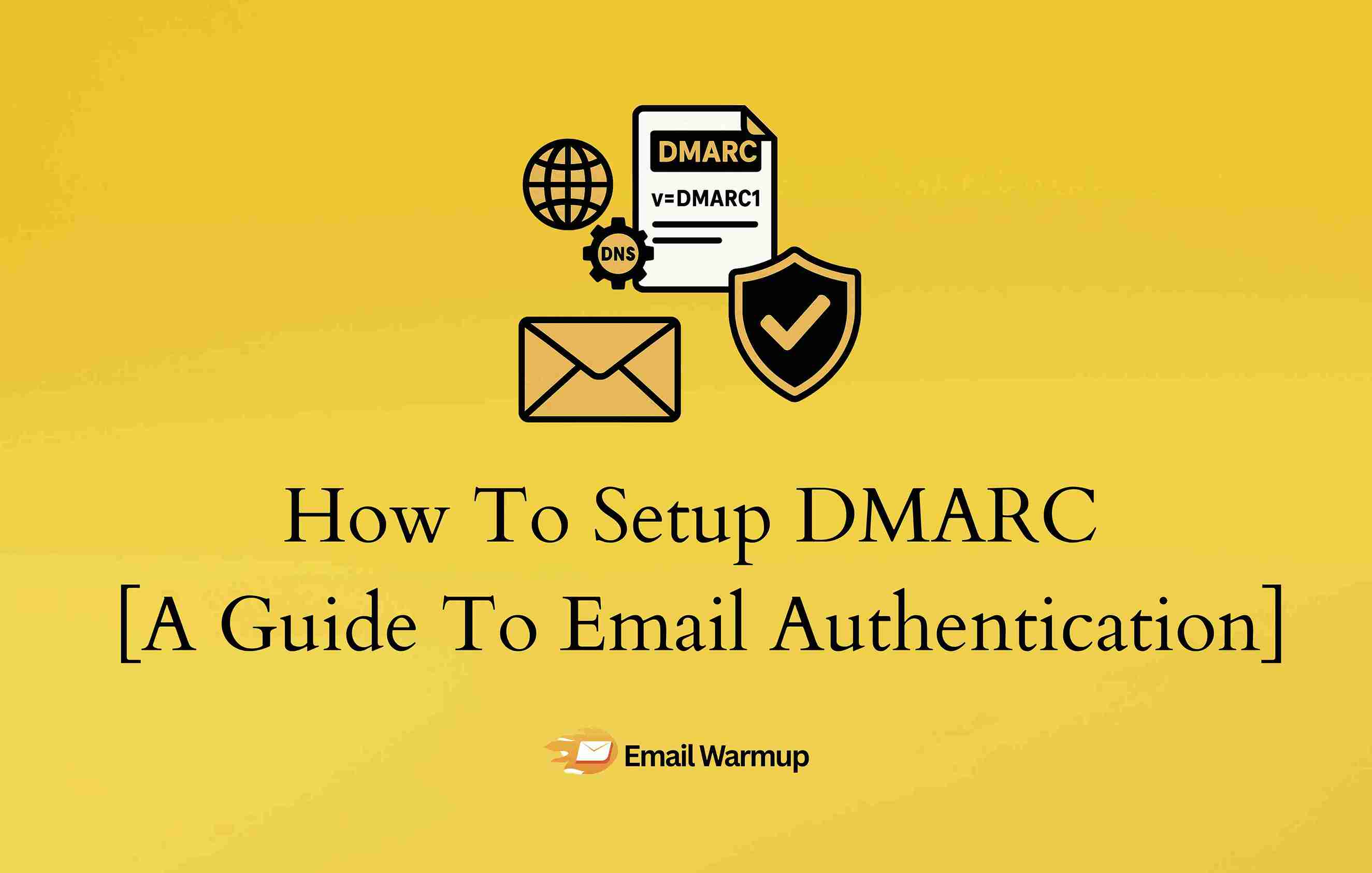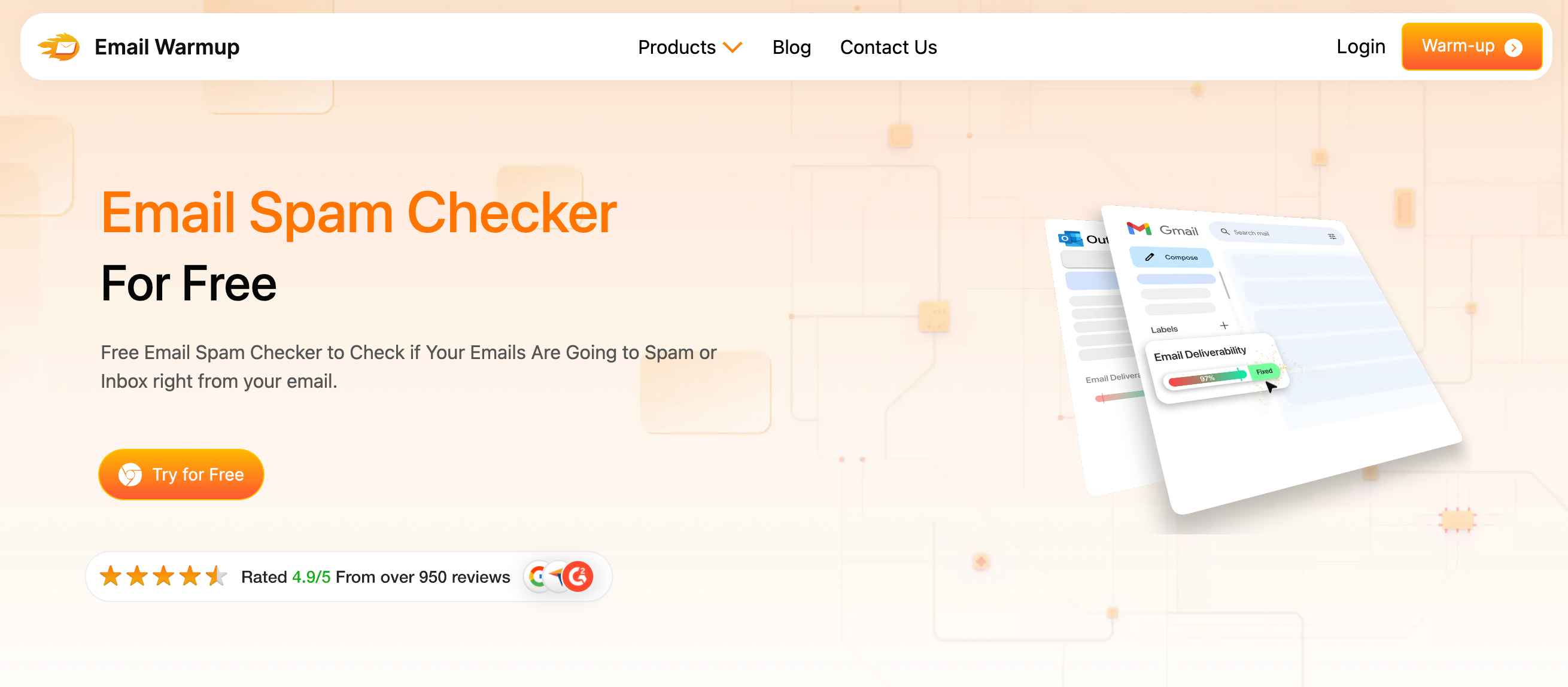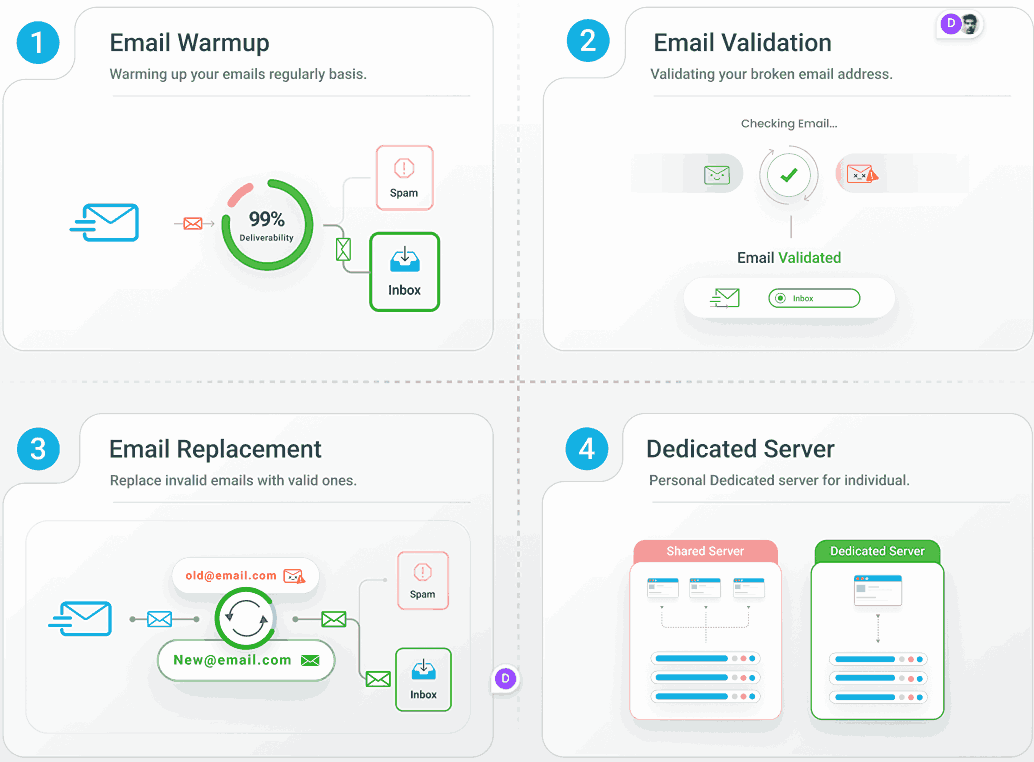
February 1, 2024, made DMARC mandatory for bulk senders. Your growing business sends emails through multiple platforms, and now you’re facing DNS records that could break email delivery with one wrong move.
You’re not alone in feeling anxious about authentication settings (especially when your team keeps asking about BIMI logos). However, proper domain-based message authentication reporting and conformance actually protects your email deliverability while meeting Gmail and Yahoo’s requirements.
As an email deliverability consultant who has helped hundreds of businesses set up DMARC without breaking their email systems, I’ve created this step-by-step guide that covers:
- DMARC prerequisites, including SPF and DKIM setup
- Safe three-phase rollout from monitoring to full enforcement
- Gmail and Yahoo bulk sender compliance requirements
- BIMI eligibility preparation and advanced configurations
- Ongoing monitoring and troubleshooting techniques
Let’s ensure you have bulletproof email authentication that protects your brand while ensuring every legitimate email reaches its destination.
Quick Implementation Overview
Here’s your roadmap for busy decision-makers who need the essential steps:
| Phase | Policy | Duration | Key actions | Gmail status |
| Discovery | p=none | 2-4 weeks | Set up DMARC record, configure reporting, inventory all senders | Basic compliance |
| Testing | p=quarantine | 4-6 weeks | Fix authentication issues, monitor with pct parameter | Enhanced protection |
| Enforcement | p=reject | Ongoing | Full protection, BIMI eligibility, continuous monitoring | Maximum security |
Get DMARC Done Right Without the Technical Headaches
Setting up domain-based message authentication across multiple email services while maintaining deliverability requires careful coordination (something most businesses don’t have time for).
EmailWarmup.com offers:
- Automated email warmup
- Ongoing compliance monitoring
- Expert troubleshooting for complex email architectures
- BIMI implementation once DMARC enforcement is stable
- Complete DMARC setup with phased rollout management
- Email authentication audits across all your sending services
We handle the technical complexity while you focus on growing your business.
Schedule your consultation call and let our experts implement DMARC safely.
What is DMARC, and why does Gmail require it?
DMARC (Domain-based Message Authentication, Reporting, and Conformance) verifies that emails claiming to come from your domain are actually legitimate. It instructs email receivers on how to handle suspicious messages.
Gmail and Yahoo introduced their February 2024 requirements as a direct response to phishing attacks and email spoofing. Without proper authentication, cybercriminals can easily impersonate your brand (and Gmail got tired of dealing with the aftermath).
Gmail and Yahoo’s mandatory requirements
For bulk senders (5,000+ messages daily to personal Gmail accounts), these requirements became non-negotiable:
- From domain aligned with either SPF or DKIM
- Both SPF and DKIM authentication set up correctly
- Spam complaint rate below 0.1% target (never reach 0.3%)
- DMARC record present in DNS (p=none acceptable for basic compliance)
- RFC 8058 one-click unsubscribe for promotional emails (honor within 48 hours)
The consequences include email filtering, spam folder placement, or complete message rejection. Once your spam rate hits 0.3%, Gmail becomes significantly more aggressive with your messages.
How DMARC connects SPF and DKIM
Email authentication works as a three-layer security system that performs DMARC checks on every incoming message.
SPF
SPF functions like a bouncer’s guest list, telling email servers which IP addresses can send email for your domain. However, SPF only checks the technical sender (not the visible “From” address that recipients see).
DKIM
DKIM works like a tamper-proof seal, adding a digital signature that proves your emails haven’t been modified and came from an authorized source.
DMARC
DMARC bridges the gap by ensuring the visible “From” address matches what SPF or DKIM authenticates. Your email passes DMARC if either SPF or DKIM passes and aligns properly with the From domain.
How do I prepare SPF and DKIM before implementing DMARC?
Before you set up DMARC, you need working SPF and DKIM across all your email services. DMARC will expose every authentication gap.
Inventory all your email services
Most growing companies send emails through multiple platforms without realizing it. Create a complete list of every service using your domain:
- Billing systems (Stripe, QuickBooks)
- CRM systems (Salesforce, Pipedrive)
- Support platforms (Zendesk, Intercom)
- Internal email (Google Workspace, Microsoft 365)
- Marketing tools (HubSpot, Mailchimp, Customer.io)
- Transactional email (SendGrid, Amazon SES, Postmark)
Each service requires proper SPF inclusion and DKIM signing —- missing even one can cause authentication failures once DMARC enforcement begins.
SPF record configuration
Your SPF record should include all legitimate sending sources while staying under the 10 DNS lookup limit:
v=spf1 include:_spf.google.com include:sendgrid.net include:customeriomail.com ~all
Watch your DNS lookup count carefully. If you exceed 10 lookups, SPF breaks completely. Consider using IP addresses directly if you’re approaching the limit.
DKIM setup across services
Every email service should have DKIM configured with your domain:
- Generate DKIM keys in your service’s authentication settings
- Add the public key to your DNS as a TXT record
- Verify signing is active for all email types
The process varies between providers, but the principle remains the same: your domain needs to cryptographically sign emails from each service.
What’s the safest way to implement DMARC without breaking email?
DMARC implementation follows three phases that prioritize safety while building complete protection.
Phase 1: Discovery mode (p=none)
Start in monitoring mode to map your email ecosystem without affecting delivery.
Create your first DMARC record
Your initial record should focus on gathering intelligence:
v=DMARC1; p=none; rua=mailto:dmarc-reports@yourdomain.com
Breaking down each component:
- v=DMARC1 – Identifies as a DMARC record
- p=none – Monitor mode (no blocking or filtering)
- rua=mailto: – Where to send daily aggregate reports
Add the record to DNS
Create a TXT record in your DNS with hostname _dmarc.yourdomain.com and the value above. Most DNS providers have intuitive interfaces (though exact steps vary by provider).
Verify your record with a DMARC checker tool after publishing. DNS changes usually appear within a few hours.
Set up report collection
DMARC reports come in XML format and can quickly become overwhelming. Consider these options:
- Dedicated email for manual review (small volumes only)
- DMARC analysis tools like dmarcian or Valimail (recommended)
- Custom scripts for technical teams comfortable with XML parsing
Expect daily aggregate reports from major email providers during discovery. These reports show who’s sending email with your domain and their authentication status.
Phase 2: Gradual enforcement (p=quarantine)
After 2-4 weeks of monitoring and fixing issues found in Phase 1, move to quarantine mode.
Implement quarantine policy
Update your DMARC record to start measured enforcement:
v=DMARC1; p=quarantine; pct=25; rua=mailto:dmarc-reports@yourdomain.com
The pct=25 means only 25% of failing messages receive quarantine treatment initially. Gradually increase the percentage:
- Week 1-2: pct=25
- Week 3-4: pct=50
- Week 5-6: pct=75
- Week 7+: pct=100
Monitor Gmail Postmaster Tools
Watch your Gmail metrics closely during enforcement:
- Spam rate – Keep below 0.1% consistently (never reach 0.3%)
- Domain reputation – Maintain “High” status (avoid “Low” or “Bad”)
- Authentication rates – Verify high SPF, DKIM, and DMARC pass rates
- Delivery errors – Watch for authentication-related bounces
If your spam rate approaches 0.1%, pause the rollout and investigate. Email content analysis tools can help review messages for potential issues.

Alternatively, you can have a better and more in-depth insight, comapred to Google Postmaster tools. You can use an email spam checker extension that doesn’t just predict where you next emails are going, but also exactly tells you where your sent emails went.
Phase 3: Full protection (p=reject)
The final phase provides maximum protection by rejecting all failed emails.
Implement reject policy
Once you’re confident in your authentication setup, implement full enforcement:
v=DMARC1; p=reject; rua=mailto:dmarc-reports@yourdomain.com
With p=reject, any email failing DMARC gets completely blocked before reaching the recipient. The dmarc1 p reject rua configuration provides maximum spoofing protection.
BIMI eligibility preparation
DMARC enforcement at p=reject (or p=quarantine) with pct=100 makes you eligible for BIMI (Brand Indicators for Message Identification).
For Gmail BIMI implementation, you need:
- DMARC at enforcement (p=quarantine or p=reject) with pct=100
- VMC (Verified Mark Certificate) or CMC certificate (VMC recommended)
- Proper BIMI TXT record with logo URL and certificate reference
Allow several weeks to ensure the reject rua mailto policy isn’t blocking legitimate email before adding BIMI complexity.
How do I handle advanced DMARC configurations?
Once basic DMARC functions smoothly, these advanced options provide better security and deliverability control.
Subdomain policies
Large organizations often use subdomains for different email types. DMARC automatically covers subdomains unless you create specific policies using the sp= tag:
# Main domain with strict policy
_dmarc.company.com: v=DMARC1; p=reject; sp=quarantine;
# Marketing subdomain with separate policy
_dmarc.marketing.company.com: v=DMARC1; p=quarantine;
Different enforcement levels work well based on email type and risk tolerance.
Alignment settings
Fine-tune alignment requirements with these parameters:
- aspf=r – Relaxed SPF alignment (default, recommended)
- aspf=s – Strict SPF alignment (exact domain match required)
- adkim=r – Relaxed DKIM alignment (default, recommended)
- adkim=s – Strict DKIM alignment (exact domain match required)
Most organizations should stick with relaxed alignment for operational flexibility while maintaining strong protection.
What are the most common DMARC problems, and how do I fix them?
DMARC implementation often reveals unexpected authentication gaps. Here’s how to address frequent issues:
Legitimate email getting blocked
When legitimate email gets blocked, you’ll see delivery issues, customer complaints, or blocked messages appearing in DMARC reports.
The fix involves reviewing all email services for proper SPF and DKIM configuration. Configure ARC (Authenticated Received Chain) for email forwarding scenarios. Work with mailing list providers to maintain authentication through forwarding.
SPF authentication failures
SPF failures in reports despite including all known services usually indicate DNS lookup count issues or service provider changes.
Check your DNS lookup count (must be 10 or fewer total lookups). Flatten SPF by replacing includes with direct IP addresses where possible. Monitor for service provider IP address changes that break authentication.
DKIM signature problems
DKIM failures in reports from specific email services typically stem from configuration issues.
Verify DKIM record format and placement in DNS. Coordinate key rotation schedules with service providers. Ensure DKIM signature domain aligns with the From domain.
Methodical analysis of DMARC reports helps identify patterns and isolate specific failure sources.
How do I maintain DMARC compliance long-term?
DMARC requires ongoing attention for sustained success.
Regular monitoring schedule
Establish a review rhythm that matches your organization’s complexity:
- Weekly during initial implementation phases
- Monthly for stable configurations
- Quarterly for comprehensive analysis
Watch for patterns suggesting new email services, infrastructure changes, or emerging spoofing attempts targeting your domain.
Key success metrics
Track these indicators to maintain healthy email authentication:
- Gmail spam rate – Keep consistently below 0.1%
- Domain reputation – Monitor through Gmail Postmaster Tools
- DMARC pass rate – Target 95%+ for all legitimate email traffic
- Authentication rates – Aim for 98%+ SPF and DKIM pass rates
Regular maintenance prevents small authentication issues from becoming major deliverability problems. Review new email service integrations for proper authentication setup.
Monitor service provider announcements about infrastructure changes and update SPF records when adding or removing email services.
Ready to implement DMARC without the stress?
DMARC implementation demands technical precision across your entire email infrastructure. One misconfigured record can block legitimate email, while inadequate monitoring leaves your domain vulnerable to spoofing attacks.

Our email authentication experts handle the complete process — from initial SPF and DKIM audits through full DMARC enforcement and BIMI implementation. We monitor your authentication health continuously, ensuring Gmail and Yahoo compliance while protecting your sender reputation.
EmailWarmup.com provides:
- Complete DMARC implementation with zero delivery disruption
- Ongoing authentication monitoring and issue resolution
- BIMI setup once DMARC enforcement proves stable
- 24/7 support for authentication emergencies
Stop worrying about DNS records and email authentication.
Frequently Asked Questions
Here are some frequently asked questions on DMARC setup:
Yes, but you’ll need to ensure each service has proper SPF inclusion and DKIM signing configured. The challenge isn’t DMARC itself — it’s coordinating authentication across all your email services. Start by inventorying every platform that sends email using your domain, then verify each one has correct SPF and DKIM setup before you set up DMARC.
Nothing changes during discovery mode (p=none). Your emails are delivered normally while DMARC collects authentication data. Aggregate reports show which emails pass or fail authentication, but no filtering or blocking occurs during the monitoring period.
Only if you send an email from both domains, DMARC applies specifically to email authentication, not website traffic. If your email comes from mail.yourcompany.com but your website is yourcompany.com, you need DMARC on the email domain where you send mail.
Technical readiness matters more than timeline. Some organizations move through phases in 8-10 weeks, while others need 16-20 weeks to address complex authentication issues. Rush implementation and risk blocking legitimate email.
DMARC actually improves marketing email deliverability by proving your emails are legitimate. However, you must ensure your marketing platform has proper DKIM signing and SPF inclusion before DMARC enforcement. Most reputable email services support DMARC authentication.
Both provide strong protection, but p=reject offers maximum security by completely blocking failed emails. p=quarantine sends failed messages to spam folders, giving recipients a chance to find false positives. For business email, p=reject is preferred once you’re confident in your authentication setup.


